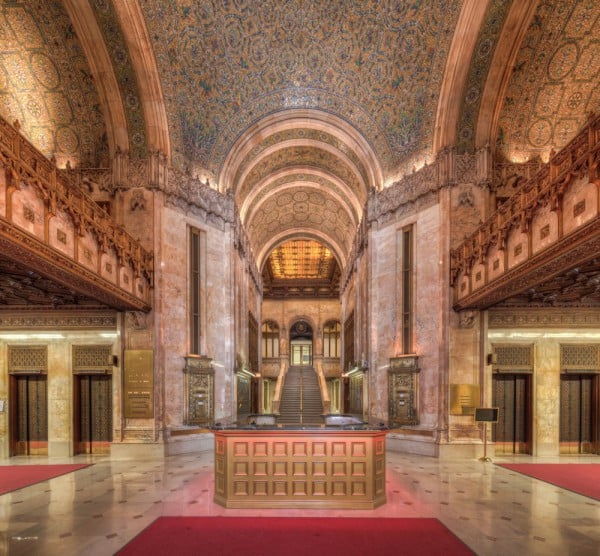Art World
The Woolworth Building: Big-box as Church
The Daily Pic: Gopnik's first column looks at the building artnet News is in.

The Daily Pic: Gopnik's first column looks at the building artnet News is in.

Blake Gopnik

This is a recent photo of the lobby of the great Woolworth Building in downtown New York, which I’m posting because I’m about to start spending time there: I’m pleased to announce that, as of today, the Daily Pic will be hosted by Artnet News, whose offices are high up in the building. (Click on my image to enlarge it.)
The average Joe was once allowed to wander into the space, but then 9/11 hit, and the corporate world got to launch its program of pseudo-security. Last year, however, two of the great-grandchildren of Cass Gilbert, the building’s architect, got permission from its owners to launch for-profit tours of the lobby, which cost $30 for a 60-minute incursion.
The Woolworth Building was begun in 1910, and after constant expansion of its plans and ambitions, by 1913 had risen to be by far the tallest building in the world, reaching up 60 stories. It was a miracle of modern engineering, using the latest in steel-frame construction and incorporating such modern technologies as high-speed elevators and the new telephone.
And all that forward-looking modernity in the building’s essence must be precisely what triggered the profound retrospection of its neo-medieval surfaces. The lobby is full of hand-carved ornament and real glass mosaic that riff on the Byzantine, the Romanesque and the Gothic. To make the radical building at all palatable, even comprehensible, to the culture around it, its futurism needed to be counterweighted with a heavy load of nostalgia—needed it every bit as much as its statics demanded a balance of loads on its frame.
The retrospection may also have had more complex social aims. The building was commissioned by Frank Winfield Woolworth, the five-and-dime magnate, as a speculative office property. (Woolworth’s corporate headquarters only took up two floors, according to Gilbert’s heirs, who also said that the building was one of the first to function as brand advertising for its owner.) Woolworth’s business models were newfangled, and they caused all sorts of social disjunctions. (“The chain stores are undermining the foundation of our entire local happiness and prosperity,” said the speaker of the Indiana House of Representatives in the late 1920s “.… sapping the life-blood of prosperous communities and leaving about as much in return as a traveling band of gypsies.”) But their newness and dislocations were counterbalanced by the lobby’s medieval fantasy, which harkens back to an imaginary time when every “man” knew his place and there was a fixed place for every man.
The Woolworth Building soon came to be called “The Cathedral of Commerce,” and cathedrals are, among other things, about defining the status quo as God’s plan. In the lobby of the Woolworth Building, American entrepreneurship becomes a new religion, at the head of a new social system that’s busy pretending that it isn’t new. It doesn’t hurt that, by building this novel sacred space, Frank Woolworth, an arriviste if ever there was one, gets to bill himself as part or even pinnacle of a stable, ancient order—as the aristocrat deeply rooted in time and place who builds a sacred monument for his dependents.
The lobby’s wondrous decoration was hand-crafted by American artisans skilled in the “timeless” techniques of carving and tessellation. That is, it celebrated a set of talents that are precisely what Woolworth didn’t want or need from the unskilled peons he employed and controlled by the tens of thousand. (“Do the mother and father realize what will happen to their children when they have to go to work for chain stores at $20 per week, or less?” asked a Missouri newspaper. The question is still being raised about Walmart; the direct corporate heir of the old Woolworth Inc. is today’s Foot Locker chain.) By showing and praising precisely what his employees lacked, old man Woolworth may have been presenting a justification for not treating them better.
But maybe what’s most interesting about the glorious medievalism of the Woolworth lobby— can’t say I don’t get a thrill walking through it—is that it wasn’t needed for long. Within a decade or so, the American public got so used to the radically modern—in buildings, but maybe also in economics—that skyscrapers could revel in their newness, instead of having to camouflage it.
For a full survey of past Daily Pics visit blakegopnik.com/archive